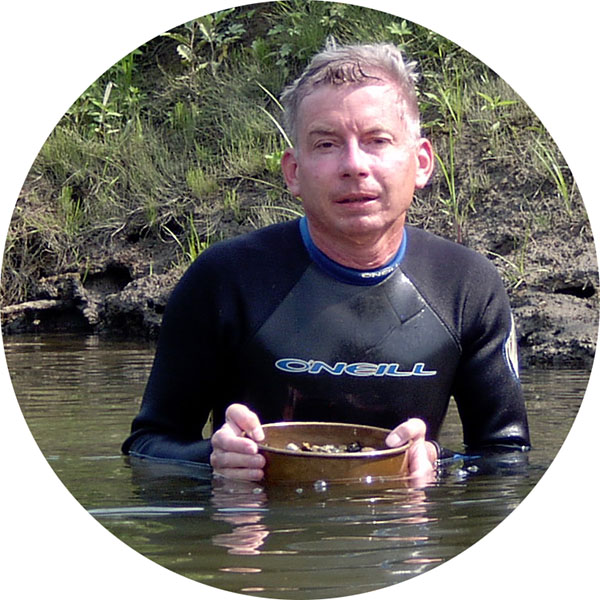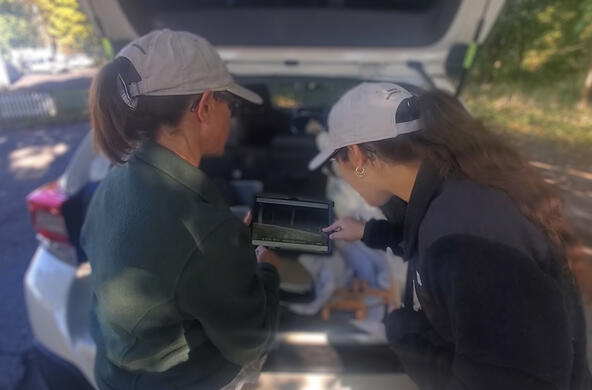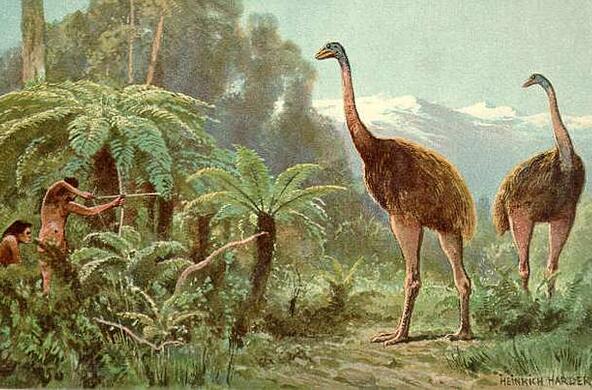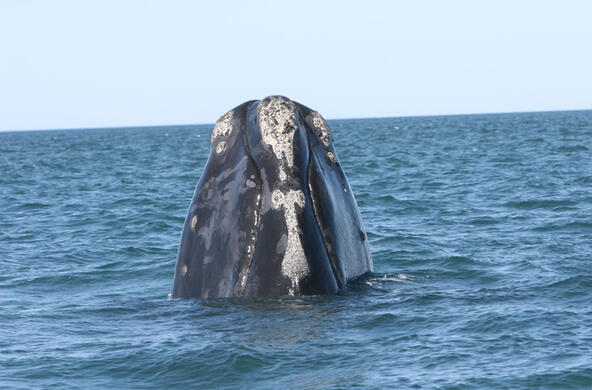De-extinction (bringing extinct species back from the dead) has been riding a wave of enthusiasm, fueled by Steward Brand’s TED talk and several prominent books and articles. But for a project that aspires to use materials from the past to build a better future, de-extinction is doing a poor job of using past experience with biological invasions to temper that enthusiasm.
The basic idea of de-extinction is to use bits of genetic material salvaged from an extinct species (museum specimens, frozen mammoths) in cutting-edge biotechnology to create living animals in the lab, and use these lab-created specimens to re-establish populations of the extinct species in the wild. Actually, as Beth Shapiro described in her excellent book How To Clone a Mammoth, the end product isn’t literally the extinct species, but an animal with some of the genes of the extinct species (the passenger pigeon) and some of the genes of a living relative (e.g., the band-tailed pigeon), which hopefully looks and acts something like the extinct species. We might call this new species “passenger pigeon v.2.0”.
I don’t need to explain the appeal of “de-extinction”. Besides using our powers to bring back charismatic species, de-extinction could restore vital functions that these lost animals performed, and thus benefit other inhabitants of their ecosystems. De-extinction is also almost irresistibly cool (come on! Bringing mammoths back from the dead?).
Much of the discussion about de-extinction has focused on the technical challenges of resurrecting extinct species, the problem of choosing which species to revive, and the danger that de-extinction could divert attention and resources away from badly needed programs to prevent further extinctions. These serious problems deserve careful consideration, and are well treated in Shapiro’s book and elsewhere. But focusing on these problems can distract us from what may be the central risk of de-extinction: that its ecological effects could be large, and hard to predict and manage.
We have learned from biological invasions that putting new species into ecosystems can have large economic and ecological effects, sometimes positive and sometimes negative, but almost always difficult or impossible to predict or control. Familiar examples include rabbits in Australia; or zebra mussels, emerald ash borers, and chestnut blight in the US, among many others. The combination of large effects, low predictability, and irreversibility makes putting new species into ecosystems, including de-extinction, a risky enterprise.
As for any human activity that poses risks to the environment, proponents of de-extinction should be able to provide good answers to three questions: What are its likely effects? What is the plan to prevent or repair unexpected damage? Why should this project be done now, instead of being deferred?
The usual answer to the first question is that the species is being returned to the ecosystem in which it lived for many years, and will simply resume its former ecological roles. This answer fails on two counts. First, because we’ve been changing our world so rapidly, a de-extinguished species won’t be restored to its former ecosystem, but to a different, sometimes radically different, ecosystem. Since the passenger pigeon was last abundant, its home in eastern North America has been transformed from forests to industrial farms, superhighways, and megalopolises; its human population has increased 5-fold; we’ve poured huge amounts of nutrients and toxins into the landscape; thousands of species from other parts of the world have become established, while others (like American chestnut) have dwindled or disappeared; and we are in the process of changing its climate.
Ecologists know that the setting into which a species is placed strongly affects its roles and impacts, so there is no reason to expect that passenger pigeon v.2.0 (or any other de-extinguished species) would simply re-assume its former roles. Experience with native North American species like white-tailed deer, Canada geese, coyotes, and Colorado potato beetles shows that the roles that these species play (and human valuation of those roles) changed radically as ecological and societal contexts changed.
The second objection to the naïve answer that a de-extinguished species would simply resume its former roles is that v.2.0 isn’t the same as the extinct species. In all but a few of the cases that are being discussed, the organism to be released won’t literally be the species that was lost, but rather a human creation that in some ways looks and acts like the lost species. This match might be pretty close, or merely superficial (e.g., a cold-hardy, hairy elephant in place of a woolly mammoth). Even small differences between v.2.0 and the original could cause large differences in roles and effects.
Again, experience with biological invasions shows that this isn’t just a theoretical possibility. When two similar species of sparrow were released in North America, one spread quickly and became a widespread nuisance (the house sparrow), while its cousin never left the St. Louis area or caused problems (the Eurasian tree sparrow). The example of the common reed (Phragmites) is even more striking. Native strains of this species were a widespread but minor part of North American wetlands. When nearly indistinguishable Eurasian strains were introduced, they formed impenetrable thickets all across North America, crowding out native plants, damaging wildlife habitat, and disrupting nutrient cycles. Wetlands managers now spend millions of dollars each year to burn, herbicide, mow, dig up, and otherwise kill Eurasian Phragmites in North America. Organisms that look like one another and share genetic material aren’t necessarily interchangable.
It is therefore wholly inadequate to assert that a de-extinguished species will merely resume its former roles, and not cause problems. Furthermore, research on biological invasions shows that it is very difficult to accurately predict the abundance and impacts of newly introduced species. Consequently, we can expect some predictions about the effects of de-extinctions to be wrong, so that some de-extinctions anticipated to be benign will cause harm. It is therefore important that a plan for controlling or repairing damage be in place before these new organisms are released. We routinely assess the likely impacts of oil wells, and require that they be built and operated responsibly, but also require spill-response plans, because we know that some spills will occur despite our best efforts. De-extinguishing species will be far less certain than drilling and operating oil wells, so “spill response” plans will be essential.
Again, the usual response given to this concern is naïve and unsatisfactory: “we removed the species before, and if it becomes a problem, we can simply remove it again”. Recall how we removed the passenger pigeon the first time: by felling millions of acres of forests and slaughtering countless birds for market. Does anyone really think that society would allow immense tracts of forest to be cut and millions of birds to be killed (for a market that doesn’t even exist today) if passenger pigeon v.2.0 turned out to cause problems? Today’s (and tomorrow’s) world is vastly different from the world from which these species were removed, so the mechanism of their original extinction probably won’t be available as a control method.
Instead of the glib answer that “we did it before, so we can do it again,” we need a credible plan to remove problematic de-extinguished species or manage their impacts. Who will decide whether control or eradication is necessary? At what point in the de-extinction process will this decision be made? What tools or methods will be effective in controlling the species or its problems? And who will pay for these efforts? We know from experience with invasive species that control or eradication of nuisance species can be costly and difficult (or impossible), so developing such “spill” plans will be challenging. However, they will be as indispensible for de-extinction as for oil drilling.
Finally, we should ask why de-extinction needs to be done as soon as possible, and not deferred. It is natural that we are eager to bring species back from the dead as soon as we can. This eagerness generates nearly irresistible momentum, but we should resist this momentum and deliberately choose the best time (if ever) to pursue de-extinction. This may mean waiting until we gather information needed to assess the benefits and risks of releasing these new organisms into nature and develop a control plan.
The recent debate about whether to allow fracking in New York is instructive. This new technology can provide large benefits (formerly inaccessible natural gas), but rushing into fracking led to large environmental problems. One approach is to defer fracking. There is no hurry in getting the gas out of the ground (it will still be there tomorrow!), and we can expect to develop better technologies and environmental controls if we wait a bit. Not “no fracking ever,” but “no fracking today.”
A similar argument could be applied to de-extinction. There is no urgency to most of the cases that are being discussed, apart from the personal desires of some people; no greater difficulty in bringing back a species in 2100 rather than 2030. On the other hand, rushing headlong into de-extinction exposes us to unnecessary risks just as rushing headlong into fracking exposed us to unnecessary environmental damages. So we deserve a good answer to the question not only of why we should bring back the passenger pigeon, but why we should bring it back today.
As an invasion biologist, it’s hard not to hear echoes of old enthusiasms in the arguments for de-extinction. (“The introduction of a few rabbits could do little harm and might provide a touch of home…[to Australia]”1, “but that so fine a plant as this [water-chestnut], with its handsome leafy rosettes, and edible nuts, … can ever become a nuisance, I can scarcely believe.”2) Over and over, naïve proponents of introductions seduced us with stories about how new species would improve ecosystems and benefit humans in myriad ways, their enthusiasm unchecked by any rigorous assessment of possible impacts or control plans.
Some of these introductions did bring benefits (although rarely the full benefits that were promised), but many caused large, lasting ecological and economic problems. This bitter experience should have taught us to be wary of the alluring stories now being told about de-extinction. If de-extinction is to proceed, we need serious consideration of its ecological effects, not romantic appeals to the imagination. Let’s not repeat old mistakes with new species, no matter how technologically advanced their pedigrees.







